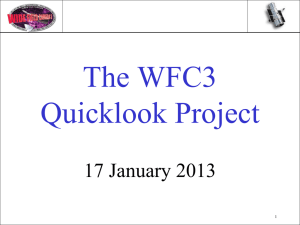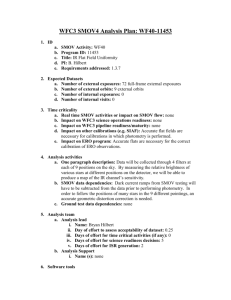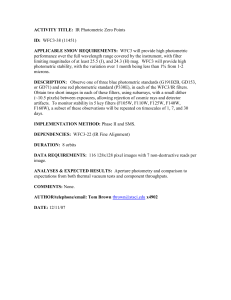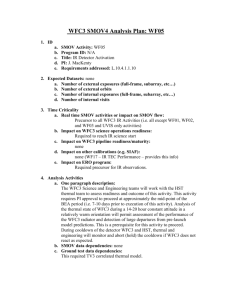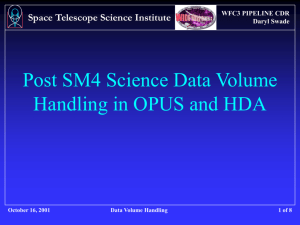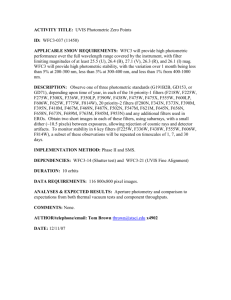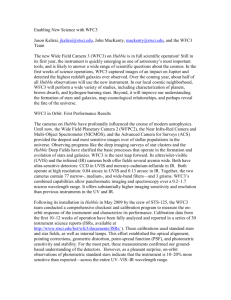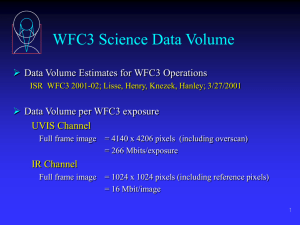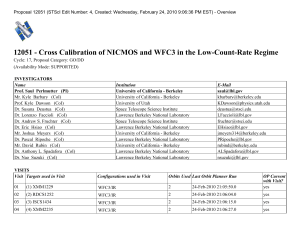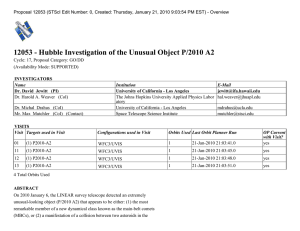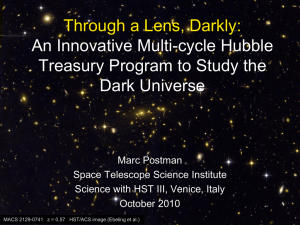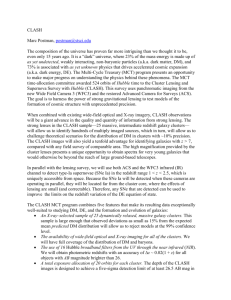10_WFC3_Status
advertisement
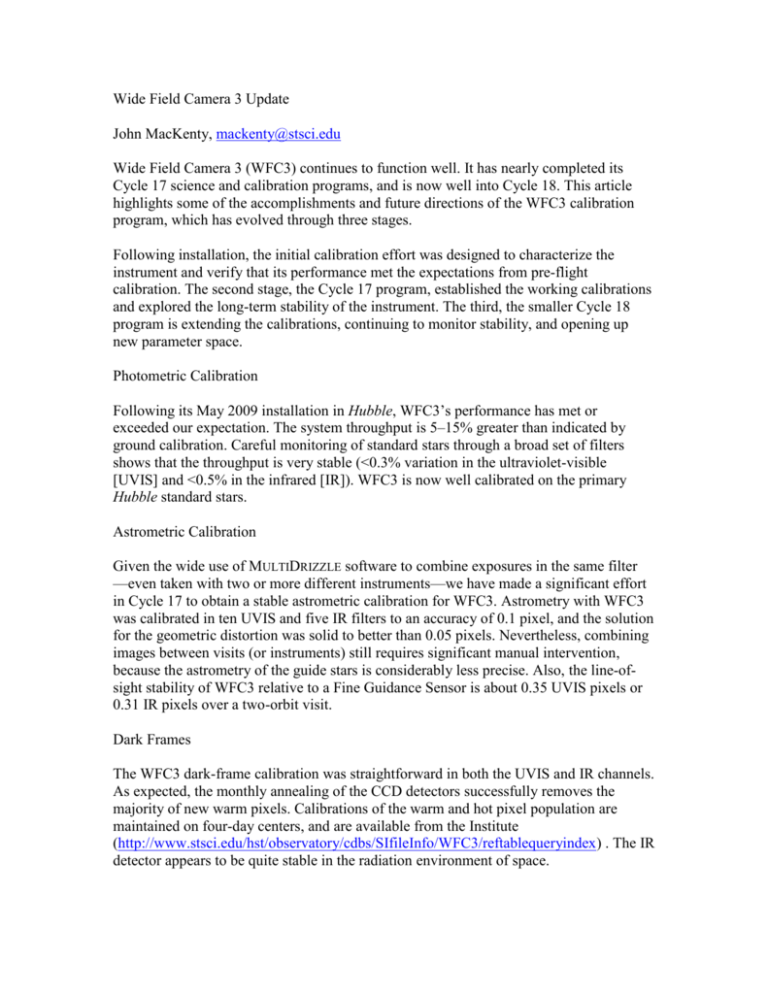
Wide Field Camera 3 Update John MacKenty, mackenty@stsci.edu Wide Field Camera 3 (WFC3) continues to function well. It has nearly completed its Cycle 17 science and calibration programs, and is now well into Cycle 18. This article highlights some of the accomplishments and future directions of the WFC3 calibration program, which has evolved through three stages. Following installation, the initial calibration effort was designed to characterize the instrument and verify that its performance met the expectations from pre-flight calibration. The second stage, the Cycle 17 program, established the working calibrations and explored the long-term stability of the instrument. The third, the smaller Cycle 18 program is extending the calibrations, continuing to monitor stability, and opening up new parameter space. Photometric Calibration Following its May 2009 installation in Hubble, WFC3’s performance has met or exceeded our expectation. The system throughput is 5–15% greater than indicated by ground calibration. Careful monitoring of standard stars through a broad set of filters shows that the throughput is very stable (<0.3% variation in the ultraviolet-visible [UVIS] and <0.5% in the infrared [IR]). WFC3 is now well calibrated on the primary Hubble standard stars. Astrometric Calibration Given the wide use of MULTIDRIZZLE software to combine exposures in the same filter —even taken with two or more different instruments—we have made a significant effort in Cycle 17 to obtain a stable astrometric calibration for WFC3. Astrometry with WFC3 was calibrated in ten UVIS and five IR filters to an accuracy of 0.1 pixel, and the solution for the geometric distortion was solid to better than 0.05 pixels. Nevertheless, combining images between visits (or instruments) still requires significant manual intervention, because the astrometry of the guide stars is considerably less precise. Also, the line-ofsight stability of WFC3 relative to a Fine Guidance Sensor is about 0.35 UVIS pixels or 0.31 IR pixels over a two-orbit visit. Dark Frames The WFC3 dark-frame calibration was straightforward in both the UVIS and IR channels. As expected, the monthly annealing of the CCD detectors successfully removes the majority of new warm pixels. Calibrations of the warm and hot pixel population are maintained on four-day centers, and are available from the Institute (http://www.stsci.edu/hst/observatory/cdbs/SIfileInfo/WFC3/reftablequeryindex) . The IR detector appears to be quite stable in the radiation environment of space. We have added to the list of “bad” pixels some optical features on the mechanized mirror that selects the channel (and is closed during focus operations). We have aggressively masked poorly behaved pixels, particularly those with occasionally anomalous dark current. Users should consider which “bad” pixel features to exclude from their observations based upon both the number of dithered exposures available and their particular science goals. Flat Frames The low-spatial-frequency flat fields (L-Flats) have proven time-consuming to calibrate. During ground calibration, we obtained both internal and external flat fields. The internal ones provide reasonable high-spatial-frequency flats (pixel-to-pixel or P-Flats), but have significant limitations regarding illumination. Their primary utility is to verify the stability of the P-Flat obtained from the external, ground-illumination system. This calibration appears very stable in all filters in both channels. The mismatch in the largescale illumination pattern, however, results in 4–5% peak-to-peak errors in the flat fields at low spatial frequencies. The high level of residual L-Flat error was expected. We made a major effort in Cycle 17 to obtain good L-Flats via repeatedly stepped exposures of the globular cluster Omega Cen (which also supported the astrometric calibration). The analysis of these data is subject to significant systematic errors, driven in part by source crowding and variations in the point-spread function (PSF) due to telescope breathing. For the IR channel, the combination of ~2000 long-exposure, broad-band images contains sufficient background flux to create a high-quality L-Flat. These data demonstrated both that the systematics in the cluster-based flats are understood and that the low-spatial-frequency errors in the ground calibrations are mostly independent of wavelength. Based on these results, we corrected all IR ground flats using the smoothed background-light L-Flats. This calibration provides the confidence needed to proceed with the L-flats derived for the star cluster for the UVIS channel, and we will release the results shortly. We are exploring the potential value of flat fields obtained using the Moon-lit Earth as an illumination source, to validate and possibly improve the flat fields. Early experiments look promising. (The sunlit Earth is too bright for broad filters in either channel, and short exposures produce streaks.) Charge Transfer Inefficiency in the WFC3 UVIS Channel In an unexpected and unhappy development, the Charge Transfer Inefficiency (CTI) of the WFC3 UVIS channel CCD detectors is increasing faster than we found for the ACS CCDs in their first year in space. Ground-based testing prior to Servicing Mission 4 indicated that the WFC3 CCDs had essentially the same susceptibility to radiation damage as the ACS CCDs. However, the observed rate of increase in CTI is ~2.5 times that of ACS in 2002–2003. The explanation appears to be timing—that WFC3 was placed in space during the solar minimum, when the charged-particle environment, mainly the South Atlantic Anomaly, is at a maximum. ACS is also experiencing an acceleration of CTI since SM4. In response to increasing CTI, we tested the Charge Injection mode (CI) for WFC3 early in Cycle 18. Despite mixed results during ground testing, the in-flight data indicate near complete correction of CTI. The CI mode injects ~13,000 electrons into every Nth row, where N is set to 10 or 17). Those rows have higher effective read noise (~15–20 electrons), but the rows in between have only slightly increased (~1 electron greater) read noise. The ACS team is in the process of developing a post-observation algorithm to correct for the impact of their (much more severe) increase in CTI. At this time, Cycle 19 WFC3 observers can expect to have both CI and the post-observation algorithm available as options to reduce the CTI of their images. Charge Persistence in the WFC3 IR Channel A well known and widespread characteristic of mercury-cadmium-telluride IR detectors is the persistent charge following observations of bright targets. In the low-background environment of WFC3, the IR detector shows significant persistence, for several hours following exposure, to sources that approach full well. This effect was known prior to launch, and observers are required to obtain dithered observations to reduce the impact on their observations. The Institute has examined the Cycle 17 and Cycle 18 proposal pools to identify targets that will produce large numbers of pixels with high levels of persistence. Wherever possible, other WFC3/IR observations are not scheduled following such exposures. Using additional characterizations of the persistence behavior, we have built a model that can both identify and—with lesser accuracy—calibrate the pixels in each observation that are expected to have additional dark current due to persistence. These mitigating steps will be useful to individual observers to correct all affected observations in their visit. During Cycle 18, we are experimenting with these algorithms and working to create a prototype pipeline to generate calibrations for each observation. High-Contrast Observations One question that has arisen in several contexts is how well WFC3 performs in highcontrast observations. Such performance was not a design goal for WFC3, nor was it characterized in ground testing or early in-flight calibrations, as the High Resolution Channel of ACS and the Near Infrared Camera and Multi-Object Spectrometer were expected to support coronagraphic observations. Nevertheless, early in Cycle 18 we performed a high-contrast experiment to determine the WFC3’s ability to measure faint sources within the extended point-spread function of a bright point source. Watch for WFC3 ISRs on this topic in early 2011. Slit-less Spectroscopy Cycle 18 saw a considerable increase in the usage of the IR slit-less spectroscopic mode of WFC3. In recognition of this, the Institute hosted a workshop 15–16 November 2010, to discuss the reduction and calibration of these data. This workshop also marked the handover of responsibility to STScI for these calibrations and user support from our colleagues at the European Space Agency’s Space Telescope European Coordinating Facility. For the past decade, they have supported the development of calibration software, ground testing, in-flight calibration, documentation, and user support for all aspects of spectroscopy with WFC3. We extend our thanks and appreciation for a job very well done. Further Information Far more detail is available on the calibration status of WFC3 in the recently released Cycle 19 version of the WFC3 Instrument Handbook, the recently updated WFC3 Data Handbook, and in numerous Instrument Science Reports available at www.stsci.edu/hst/wfc3.
